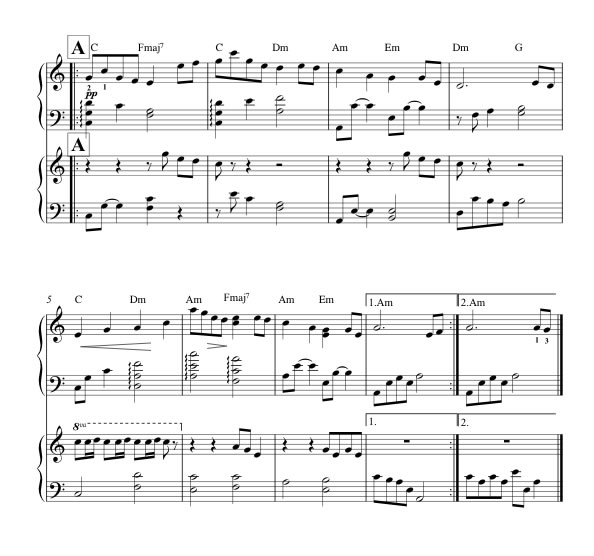Birds
Of Blue Ridge
The Birds of Blue Ridge duet arrangment can be found
in Sweepin' the Clouds Away and in Beautiful Dreams for Twin Harps.
A note from Anna
The variety of bird sounds Sharon and I could hear at Chimney Rock,
North Carolina, was the inspiration for this tune. Some of the birds
made short, chirpy sounds while others sang long, lovely serenades.
As we toured area museums and gift shops, we happened onto a recording
of North Carolina bird sounds. It occurred to us we could transcribe
the bird sounds into musical notation! So, equipped with a soprano
recorder and a harp, we set to work. It was fascinating to learn about
each bird’s appearance, habitat, and native region, and then
try to notate its song. Naturally, our next step was to combine
these birdsongs and write our own music. Our evening writing sessions
at the cottage where we stayed became as much fun as our daytime hiking
and picture-taking adventures on the beautiful Blue Ridge Parkway!
Here are some of the birds singing in our music, Birds of Blue Ridge:
 Summer
Tanager –The male is bright red; the
female is greenish yellow. This bird is found in Southern forests.
It catches bees and wasps in flight, rubs off the stinger, and eats
them! The beautiful song of this bird was the initial inspiration
for our song, Birds of Blue Ridge. Its long series of slurred and whistled
tones was unlike anything we had heard. In our music, we wrote a two-measure
pattern that begins Sharon’s solo arrangement and is found in
the Harp 3 part at measures 10-11 of my ensemble arrangement. Summer
Tanager –The male is bright red; the
female is greenish yellow. This bird is found in Southern forests.
It catches bees and wasps in flight, rubs off the stinger, and eats
them! The beautiful song of this bird was the initial inspiration
for our song, Birds of Blue Ridge. Its long series of slurred and whistled
tones was unlike anything we had heard. In our music, we wrote a two-measure
pattern that begins Sharon’s solo arrangement and is found in
the Harp 3 part at measures 10-11 of my ensemble arrangement.
 White-throated Sparrow – This small songbird
has a white throat, white and black stripes on its head, and yellow
in front of its eyes. Though it breeds in Canada, it winters in the
eastern U.S. In our melody we used its distinctive descending
major or minor 2nd intervals followed by a descending minor 3rd. White-throated Sparrow – This small songbird
has a white throat, white and black stripes on its head, and yellow
in front of its eyes. Though it breeds in Canada, it winters in the
eastern U.S. In our melody we used its distinctive descending
major or minor 2nd intervals followed by a descending minor 3rd.
 Whip-poor-will – With
its nocturnal habits, the Whip-poor-will is seldom seen during the
day. Its name reflects the rhythm of its song. The melody sounded to
us like a descending major 2nd followed by an ascending major 3rd,
repeated several times, which we also worked into our melody. Whip-poor-will – With
its nocturnal habits, the Whip-poor-will is seldom seen during the
day. Its name reflects the rhythm of its song. The melody sounded to
us like a descending major 2nd followed by an ascending major 3rd,
repeated several times, which we also worked into our melody.
 Red-winged
Blackbird – Found all over the U.S.,
the male is black with a patch of red, tinged with yellow and white
on its wing. His mating song opens my ensemble piece with Harp 3 playing
a descending octave followed by an ascending minor 7th. Red-winged
Blackbird – Found all over the U.S.,
the male is black with a patch of red, tinged with yellow and white
on its wing. His mating song opens my ensemble piece with Harp 3 playing
a descending octave followed by an ascending minor 7th.
 Tufted
Titmouse – This sweet little bird looks
like a gray-colored mini-Bluejay. It lives throughout the entire eastern
half of the U.S. It joins the red-winged blackbird in the Harp 2 part,
measure 3, of the ensemble version, with its very distinctive repeated
descending minor 3rd pattern. Tufted
Titmouse – This sweet little bird looks
like a gray-colored mini-Bluejay. It lives throughout the entire eastern
half of the U.S. It joins the red-winged blackbird in the Harp 2 part,
measure 3, of the ensemble version, with its very distinctive repeated
descending minor 3rd pattern.
 Rose-breasted Grosbeak – The male is the star,
with patches of black and white on his wings, a white beak, and a rose-colored
breast. He shares egg incubation duty with his mate, and they sing
to each other as they trade shifts! Their song (sounding like “a
robin that has taken singing lessons”) has quick, ascending major
2nds in a skipping rhythm. It enters the ensemble at measure 4 of the
Harp 1 part. Rose-breasted Grosbeak – The male is the star,
with patches of black and white on his wings, a white beak, and a rose-colored
breast. He shares egg incubation duty with his mate, and they sing
to each other as they trade shifts! Their song (sounding like “a
robin that has taken singing lessons”) has quick, ascending major
2nds in a skipping rhythm. It enters the ensemble at measure 4 of the
Harp 1 part.
 Mourning
Dove – Found in all terrains -- forests, farmlands,
deserts, and inner cities -- this is among the 10 most abundant birds
in the U.S. It is well named; its slow, ascending and descending
perfect 4th tones sound mournful indeed. The mourning dove
enters in measure 5 of the ensemble version’s Cello/Low Recorder
part. Mourning
Dove – Found in all terrains -- forests, farmlands,
deserts, and inner cities -- this is among the 10 most abundant birds
in the U.S. It is well named; its slow, ascending and descending
perfect 4th tones sound mournful indeed. The mourning dove
enters in measure 5 of the ensemble version’s Cello/Low Recorder
part.
Here's an excerpt:

Go back to the books
|

 Summer
Tanager –The male is bright red; the
female is greenish yellow. This bird is found in Southern forests.
It catches bees and wasps in flight, rubs off the stinger, and eats
them! The beautiful song of this bird was the initial inspiration
for our song, Birds of Blue Ridge. Its long series of slurred and whistled
tones was unlike anything we had heard. In our music, we wrote a two-measure
pattern that begins Sharon’s solo arrangement and is found in
the Harp 3 part at measures 10-11 of my ensemble arrangement.
Summer
Tanager –The male is bright red; the
female is greenish yellow. This bird is found in Southern forests.
It catches bees and wasps in flight, rubs off the stinger, and eats
them! The beautiful song of this bird was the initial inspiration
for our song, Birds of Blue Ridge. Its long series of slurred and whistled
tones was unlike anything we had heard. In our music, we wrote a two-measure
pattern that begins Sharon’s solo arrangement and is found in
the Harp 3 part at measures 10-11 of my ensemble arrangement.  White-throated Sparrow – This small songbird
has a white throat, white and black stripes on its head, and yellow
in front of its eyes. Though it breeds in Canada, it winters in the
eastern U.S. In our melody we used its distinctive descending
major or minor 2nd intervals followed by a descending minor 3rd.
White-throated Sparrow – This small songbird
has a white throat, white and black stripes on its head, and yellow
in front of its eyes. Though it breeds in Canada, it winters in the
eastern U.S. In our melody we used its distinctive descending
major or minor 2nd intervals followed by a descending minor 3rd. Whip-poor-will – With
its nocturnal habits, the Whip-poor-will is seldom seen during the
day. Its name reflects the rhythm of its song. The melody sounded to
us like a descending major 2nd followed by an ascending major 3rd,
repeated several times, which we also worked into our melody.
Whip-poor-will – With
its nocturnal habits, the Whip-poor-will is seldom seen during the
day. Its name reflects the rhythm of its song. The melody sounded to
us like a descending major 2nd followed by an ascending major 3rd,
repeated several times, which we also worked into our melody. Red-winged
Blackbird – Found all over the U.S.,
the male is black with a patch of red, tinged with yellow and white
on its wing. His mating song opens my ensemble piece with Harp 3 playing
a descending octave followed by an ascending minor 7th.
Red-winged
Blackbird – Found all over the U.S.,
the male is black with a patch of red, tinged with yellow and white
on its wing. His mating song opens my ensemble piece with Harp 3 playing
a descending octave followed by an ascending minor 7th. Tufted
Titmouse – This sweet little bird looks
like a gray-colored mini-Bluejay. It lives throughout the entire eastern
half of the U.S. It joins the red-winged blackbird in the Harp 2 part,
measure 3, of the ensemble version, with its very distinctive repeated
descending minor 3rd pattern.
Tufted
Titmouse – This sweet little bird looks
like a gray-colored mini-Bluejay. It lives throughout the entire eastern
half of the U.S. It joins the red-winged blackbird in the Harp 2 part,
measure 3, of the ensemble version, with its very distinctive repeated
descending minor 3rd pattern. Rose-breasted Grosbeak – The male is the star,
with patches of black and white on his wings, a white beak, and a rose-colored
breast. He shares egg incubation duty with his mate, and they sing
to each other as they trade shifts! Their song (sounding like “a
robin that has taken singing lessons”) has quick, ascending major
2nds in a skipping rhythm. It enters the ensemble at measure 4 of the
Harp 1 part.
Rose-breasted Grosbeak – The male is the star,
with patches of black and white on his wings, a white beak, and a rose-colored
breast. He shares egg incubation duty with his mate, and they sing
to each other as they trade shifts! Their song (sounding like “a
robin that has taken singing lessons”) has quick, ascending major
2nds in a skipping rhythm. It enters the ensemble at measure 4 of the
Harp 1 part. Mourning
Dove – Found in all terrains -- forests, farmlands,
deserts, and inner cities -- this is among the 10 most abundant birds
in the U.S. It is well named; its slow, ascending and descending
perfect 4th tones sound mournful indeed. The mourning dove
enters in measure 5 of the ensemble version’s Cello/Low Recorder
part.
Mourning
Dove – Found in all terrains -- forests, farmlands,
deserts, and inner cities -- this is among the 10 most abundant birds
in the U.S. It is well named; its slow, ascending and descending
perfect 4th tones sound mournful indeed. The mourning dove
enters in measure 5 of the ensemble version’s Cello/Low Recorder
part. 